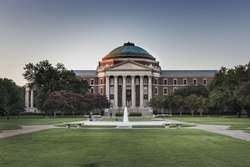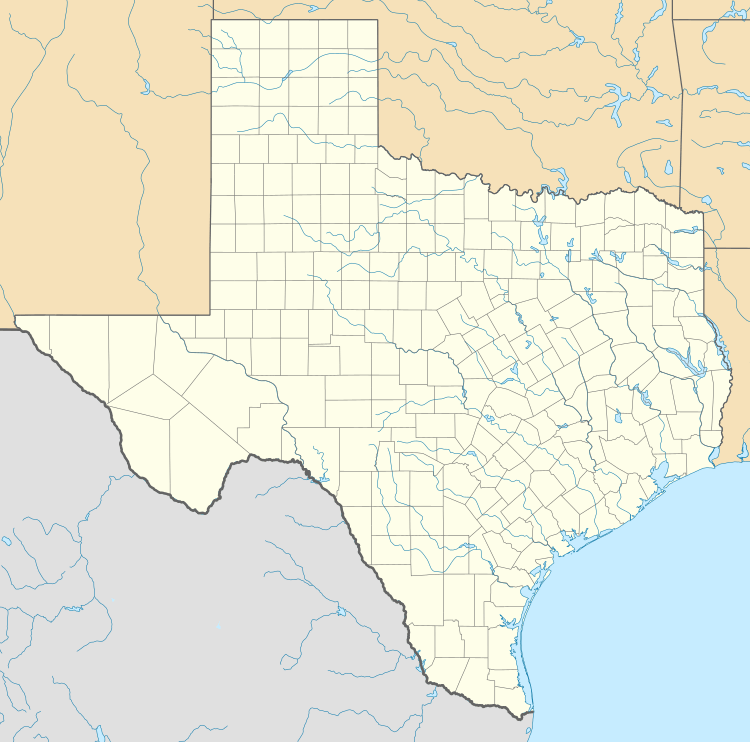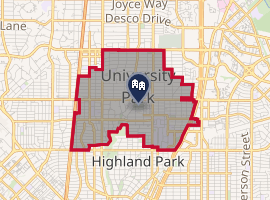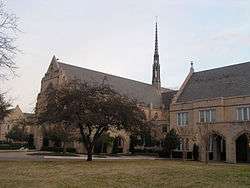University Park, Texas
University Park is a city in Dallas County, Texas, United States of America, an inner northern suburb of Dallas. The population was 23,068 at the 2010 census.[5] The city is home to Southern Methodist University.
University Park, Texas | |
|---|---|
| City of University Park | |
 Dallas Hall, on the campus of Southern Methodist University | |
 Location of University Park in Dallas County, Texas | |
 University Park Location in Texas | |
| Coordinates: 32°50′58″N 96°47′31″W | |
| Country | |
| State | |
| County | Dallas |
| Government | |
| • Type | Council-Manager |
| • City Council | Mayor Olin Burnett Lane, Jr. Liz Farley Taylor Armstrong Randy Biddle Gage Prichard |
| • City Manager | Robbie Corder |
| Area | |
| • Total | 3.69 sq mi (9.57 km2) |
| • Land | 3.69 sq mi (9.55 km2) |
| • Water | 0.01 sq mi (0.02 km2) |
| Elevation | 548 ft (167 m) |
| Population (2010) | |
| • Total | 23,068 |
| • Estimate (2019)[2] | 24,985 |
| • Density | 6,778.35/sq mi (2,617.30/km2) |
| Time zone | UTC-6 (Central) |
| • Summer (DST) | UTC-5 (Central) |
| ZIP code | 75205 & 75225 |
| Area code(s) | 214 |
| FIPS code | 48-74492[3] |
| GNIS feature ID | 1377191[4] |
| Website | www |

| |
University Park is bordered on the north, east and west by Dallas and on the south by the town of Highland Park. University Park and Highland Park together comprise the Park Cities, an enclave of Dallas. University Park is one of the most affluent places in Texas based on per capita income; it is ranked #12. In 2018, data from the American Community Survey revealed that University Park was the 2nd wealthiest city in the United States - with a median household income of $198,438 and a poverty rate of 4.2%.[6]
Addresses in University Park may use either "Dallas, Texas" or "University Park, Texas" as the city designation, although the United States Postal Service prefers the use of the "Dallas, Texas" designation for the sake of simplicity.[7] The same is true for mail sent to Highland Park.
History

University Park began as a cluster of homes surrounding the fledgling Southern Methodist University, which was founded in the then-rural Dallas County in 1915. The university supplied these homes with utility service until 1924, when the growing population could no longer be supported by the school's utilities. In response, the area's homeowners first sought annexation into the town of Highland Park, but were refused due to the high cost that would have been required to provide the necessary utility and safety services. Shortly thereafter, Dallas also refused a request for annexation on similar grounds.
Community leaders organized to incorporate as a separate individual city. According to state law, incorporation required that area residents hold an election on the issue before the new city could be officially formed and recognized. On April 24, 1924, voters approved the measure by a 5:1 margin. Operating under the commission form of government, the city began the work of shaping the new government and addressing the pressing need to establish basic municipal services. To provide for the financial needs of the city, another election was held soon thereafter to authorize the issuance of municipal bonds. Passing by a near unanimous margin, the $150,000 bond issue funded the installation of a new water supply system, street paving, and the construction of a new city hall and fire station. When first incorporated, the city encompassed 515 acres (2.08 km2), 380 homes, and 1200 residents.
As a result of efforts to build and improve the city, University Park grew to a population of over 20,000 residents by 1945 and had become one of the most prestigious locations in the area. In fact, the community's attractiveness and tax value had risen to such an extent that the city of Dallas now wanted to annex University Park into its boundaries. At the time of the election, even the Board of Commissioners favored the election. In the largest voter turnout to that date and still one of the largest in city history, the annexation was denied by a 53% to 47% margin.
In 1946 an election to adopt a Home Rule Charter was held, but the measure failed and the city continued to operate as a General Law city. In 1989 voters approved a Home Rule Charter which officially adopted a council-manager form of government and expanded the three member board of Commissioners into a five-member city council.
Since the 1940s, the population and area of University Park has stabilized at 24,000 residents and 2,350 acres (4.7 square miles). The city is now surrounded by Dallas on three sides and the town of Highland Park to the south.
Originally University Park was a middle class community.[8] Highland Park residents spearheaded the creation of the Highland Park Independent School District and asked the neighbors to the north to become a part of the district; taxes were lower since the district included University Park's population.[9] HPISD had no racial diversity in the 1950s and 1960s, when other Dallas-area school districts dealt with racial integration and white flight. The federal court orders to integrate had no effect in HPISD since it did not receive federal money.[10] As a result, values of HPISD-zoned properties in University Park rose dramatically and the demographic makeup became wealthier, with smaller houses being replaced by larger ones circa the 1970s.[11]
Geography
According to the United States Census Bureau, the city has a total area of 3.7 square miles (9.6 km2), of which 3.7 square miles (9.6 km2) is land and 0.27% is water.[12]
Demographics
| Historical population | |||
|---|---|---|---|
| Census | Pop. | %± | |
| 1930 | 4,200 | — | |
| 1940 | 14,458 | 244.2% | |
| 1950 | 24,275 | 67.9% | |
| 1960 | 23,202 | −4.4% | |
| 1970 | 23,498 | 1.3% | |
| 1980 | 22,254 | −5.3% | |
| 1990 | 22,259 | 0.0% | |
| 2000 | 23,324 | 4.8% | |
| 2010 | 23,068 | −1.1% | |
| Est. 2019 | 24,985 | [2] | 8.3% |
| U.S. Decennial Census[13] | |||
As of the census[3] of 2000, there were 23,324 people, 8,005 households, and 5,291 families residing in the city. The population density was 6,269.2 people per square mile (2,420.8/km2). There were 8,492 housing units at an average density of 2,282.5 per square mile (881.4/km2). The racial makeup of the city was 94.33% White, 1.43% African American, 0.22% Native American, 2.23% Asian, 0.02% Pacific Islander, 0.93% from other races, and 0.84% from two or more races. Hispanic or Latino of any race were 3.10% of the population.
In terms of formal education, University Park was Texas' best educated city, edging out Highland Park, with 82.8% of adults age 25 years or older holding an associate degree or higher, and 80.5% of adult residents possessing a baccalaureate degree or higher.
There were 8,005 households, out of which 40.8% had children under the age of 18 living with them, 56.7% were married couples living together, 7.6% had a female householder with no husband present, and 33.9% were non-families. 27.6% of all households were made up of individuals, and 8.0% had someone living alone who was 65 years of age or older. The average household size was 2.59 and the average family size was 3.26.
In the city, the population was spread out, with 28.2% under the age of 18, 16.4% from 18 to 24, 26.2% from 25 to 44, 21.3% from 45 to 64, and 7.9% who were 65 years of age or older. The median age was 31 years. For every 100 females, there were 87.2 males. For every 100 females age 18 and over, there were 83.1 males.
According to a 2007 estimate,[14] the median income for a household in the city was $151,418, and the median income for a family was $200,000+, making University Park the seventh most affluent neighborhood in the USA. Males had a median income of $100,000 versus $44,007 for females. The per capita income for the city was $63,414. About 3.3% of families and 5.9% of the population were below the poverty line, including 3.9% of those under age 18 and 1.8% of those age 65 or over.
Education
Primary and secondary schools
University Park is served by the Highland Park Independent School District (HPISD). As such, it is served by the HPISD's McCulloch Intermediate School and Highland Park Middle School (which share a campus located partially in Highland Park and partially in University Park),[15] and Highland Park High School located in University Park. There are two HPISD elementary schools located in University Park (Hyer and University Park), two HPISD elementary schools located in neighboring Highland Park (Armstrong and Bradfield) and one elementary school located in the city of Dallas (Michael M. Boone Elementary). All five elementary schools serve sections of the UP city limits.[16]
A small portion of University Park west of North Central Expressway is in the Dallas Independent School District.[17][18]
Colleges and universities
Southern Methodist University is located in the city of University Park. The Meadows Museum, which houses the largest collection of Spanish art in the United States, can be found on campus.
Dallas County Community College District operates nearby community colleges.
Public libraries
.jpg)
The new University Park Public Library location is the second floor of Preston Center Plaza.[19] The old location was the first floor of a Chase Bank building at the southern end of Snider Plaza, at the intersection of Daniel and Hillcrest.[20] The owner of the former building, Albert Huddleston, charged the city $1 per year to use the building space, as of 2009.[21]
The library opened on June 7, 2001 as the University Park Book Bank in Snider Plaza. Before this, the town had no library. Residents could pay to use the Highland Park Public Library or the Dallas Public Library. On April 1, 2002 the book bank became a municipal library.[21]
Parks and recreation
The City of University Park operates several parks. They include Burleson Park, Caruth Park, Coffee Park, Curtis Park, Elena's Children's Park, Germany Park, Goar Park, Linear Park, Smith Park, and Williams Park.[22]
Burleson Park was named after James B. Burleson, who served as the Mayor Pro-tem and the city commissioner. University Park mayor H. E. Yarbrough dedicated the park on September 5, 1947.[23] Elena Children's Park was named after Mary Elena Franklin, a girl who died at the age of three in an automobile accident on August 2, 1997. Over 500 corporations, families, and foundations contributed to the park.[24]
The Holmes Aquatic Center, within Curtis Park, has a 50-meter (160 ft) pool, 1-meter (3.3 ft) and 3-meter (10 ft) diving boards, a water slide, and an accessibility ramp. The park also has a pool for younger children and a 1,500-square-foot (140 m2) sprayground. University Park residents and residents of the Highland Park Independent School District are permitted to use the park.[25] The city operates six tennis courts available only to University Park residents. Parks with tennis courts include Burleson, Caruth, Curtis, Germany, Smith, and Williams.[26]
Gallery
.jpg) City Hall
City Hall
Notable people
- Colin Ridgway[27]
- Doak Walker, 1948 Heisman Trophy winner at SMU, 1945 graduate of Highland Park High School
- John Hinckley, Jr., would-be assassin of President Ronald Reagan grew up in University Park[28] and a graduate of Highland Park High School[29]
- Morgan Meyer, Republican state representative from District 108; resides in University Park
References
- "2019 U.S. Gazetteer Files". United States Census Bureau. Retrieved August 7, 2020.
- "Population and Housing Unit Estimates". United States Census Bureau. May 24, 2020. Retrieved May 27, 2020.
- "U.S. Census website". United States Census Bureau. Retrieved 2008-01-31.
- "US Board on Geographic Names". United States Geological Survey. 2007-10-25. Retrieved 2008-01-31.
- "Profile of General Population and Housing Characteristics: 2010 Demographic Profile Data (DP-1): University Park city, Texas". United States Census Bureau. Retrieved January 19, 2012.
- "The 10 wealthiest cities in the United States". Tribune Media.
- http://zip4.usps.com/zip4/zcl_3_results.jsp
- Gray, A.W. Poisoned Dreams: A True Story of Murder, Money, and Family Secrets. AudioGO, September 15, 2014. ISBN 1482101874, 9781482101874. Google Books PT138.
- Gray, A.W. Poisoned Dreams: A True Story of Murder, Money, and Family Secrets. AudioGO, September 15, 2014. ISBN 1482101874, 9781482101874. Google Books PT140.
- Gray, A.W. Poisoned Dreams: A True Story of Murder, Money, and Family Secrets. AudioGO, September 15, 2014. ISBN 1482101874, 9781482101874. Google Books PT140-PT141.
- Gray, A.W. Poisoned Dreams: A True Story of Murder, Money, and Family Secrets. AudioGO, September 15, 2014. ISBN 1482101874, 9781482101874. Google Books PT144-PT145.
- "US Gazetteer files: 2010, 2000, and 1990". United States Census Bureau. 2011-02-12. Retrieved 2011-04-23.
- "Census of Population and Housing". Census.gov. Retrieved June 4, 2015.
- "University Park city, Texas". US Census Bureau. Archived from the original on 2020-02-10. Retrieved 2009-05-14.
- "City of University Park." (map) City of University Park. Retrieved on December 7, 2011.
- "HPISD Boundary Map." Highland Park Independent School District. Accessed September 29, 2018.
- "University Park Map." City of University Park. Retrieved on June 8, 2016.
- "2015-16 Woodrow Wilson High Attendance Zone Grades 9-12." Dallas Independent School District. Retrieved on June 8, 2016.
- "Archived copy". Archived from the original on 2013-02-15. Retrieved 2013-02-14.CS1 maint: archived copy as title (link) Retrieved on February 13, 2013.
- "Hours & Location Archived 2012-02-01 at the Wayback Machine." University Park Public Library. Retrieved on November 29, 2011.
- "Friends of the University Park Public Library." University Park Public Library. Retrieved on November 29, 2011.
- "Parks Map Archived 2004-07-21 at the Wayback Machine." (Map) City of University Park. Retrieved on November 29, 2011.
- "Burleson Park Archived 2013-04-16 at Archive.today." City of University Park. Retrieved on November 29, 2011.
- "Elena's Children's Park Archived 2012-09-15 at Archive.today." City of University Park. Retrieved on November 29, 2011.
- "Pool Archived 2006-06-16 at the Wayback Machine."City of University Park. Retrieved on November 29, 2011.
- "Tennis Courts Archived 2006-06-16 at the Wayback Machine." City of University Park. Retrieved on November 29, 2011.
- Michaud, Stephen G. "Killers Among Us." Dallas Observer. Thursday March 28, 2002. Retrieved on March 31, 2016.
- Wolf, Julie. "Biography: John Hinckley Jr". The American Experience. PBS. Retrieved September 19, 2013.
- "John Hinckley Jr. brings infamy to Lubbock". Lubbock Avalanche-Journal. 2008. Archived from the original on September 25, 2013. Retrieved August 5, 2013.
External links
| Wikimedia Commons has media related to University Park, Texas. |
.jpg)


